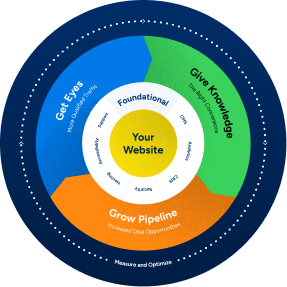B2B website development is about far more than clever designs and interesting visuals. Your company’s website represents you and the impression it leaves on visitors will directly impact how they feel about your brand. That is why careful planning of a B2B website is crucial and needs to be taken seriously.
With good planning, you can create a website that will attract your target audience, get them interested in your products or services, and make them come back again and again.
But before you can dream about all the customer retention and boosted sales you can enjoy, you need to nail the website planning phase.
If you’re unsure about how to properly plan your B2B website, stick around. This article will discuss all the points of interest so you can come up with a brilliant planning phase that will ensure a successful website build.
Define Business Goals
Before you jump into the planning phase, you need to have a good idea of what your business goals with your website are. Without knowing what you want your B2B website to do for your business, you won’t be able to build a website that achieves any milestones.
Your goals need to be specific, measurable, achievable, relevant, and time-bound so you can keep track of your progress. You must detail all your goals clearly and avoid any vague descriptions.
For example, ‘attract visitors from our area between the ages of 20-30 interested in our product’ is a better goal than ‘attract website visitors’. You have more information to work with, making measuring the results easier.
When you have defined goals, it’s also easier to add extra features or design a custom website for your company.
Create a Company Profile
For a high-quality website build, you need to create a company profile that documents all the strategic elements of your business. It’s important that you clearly define your services and/or products that you want to present on your B2B website.
At this point, you also need to create customer profiles. It’s important that you understand your ideal customers and know why they will choose to support your company. If your target audience is catering companies, you need to know everything about their industry so you know their pain points and how to solve their problems, for example.
Your company profile should also include a lot of information about your competition. You’ll have to know your competitors, how they operate, and the kind of strategies they employ. Learning from them is a good idea, as long as you don’t cross the line and mimic what they do—that’s unprofessional.
Create a Strategy
The next step in your B2B website planning phase is all about building digital marketing strategies and choosing the best one. As part of this planning, you’ll decide how digital channels will fit into your overall business strategy.
You need to define your customers’ buying and selling cycles. How long will it take your potential customers to make a purchase? How can you encourage them along the way?
You’ll also have to decide which marketing channels you want to invest in. This will be influenced by where your customers spend most of their time online. If they’re business professionals, you may have more success creating marketing strategies for LinkedIn, for example.
The kind of content you want to create for your website should also be decided upon during this planning. Knowing your target audience is crucially important so you can create content that will entertain them and increase engagement.
Your marketing funnels must also be discussed—which paths can you present to your visitors to turn them into returning customers? How can you make it easy for visitors to learn more about your products or services?
Define Website Architecture
Your website architecture is the hierarchical structure of all your web pages. The way your pages are linked is an important part of your website’s architecture.
There are several technical aspects of your B2B website that you need to define and discuss as well, such as what your menus will look like. You’ll also determine how the buttons and banners on your website will look, and what kind of images you’ll be using.
It is important to come up with design templates so it’s easy for you and your team to know how to structure landing pages and other important parts of your website.
Having well-planned website architecture will make it easier for search engine crawlers to understand how your website is linked internally, improving your SEO.
Identify the Current Website’s Flaws
If you already have a website, you need to take a critical look at it and find any existing flaws. Knowing what you’re doing wrong is the first step toward doing things the right way. You will have to take a close look at your entire website and make sure you’re following the best practices.
Do you have clearly defined marketing funnels? Have they been set up properly? What does the current website’s architecture look like? Is it easy to navigate the website and find important product or service information? Design pleasing and efficient?
Is the current content answering your visitors’ questions? Does it offer them value? How about your social media buttons? Are they placed strategically?
These are the kinds of questions you should be asking yourself about your current website. Inspect your website and make sure to note everything that needs to be improved or completely changed.
Plan Continuous Improvement
Once you have worked out a comprehensive plan for your website and feel satisfied with your work, you can start implementing the ideas. However, the hard work won’t stop there.
As soon as your website is live, you need to monitor its performance and always keep a close eye on what’s going on. Don’t settle for a good website when you can have an awesome website.
In the digital world, things are always shifting and changing, and if you want your B2B website to thrive and achieve your business goals, you have to be capable of shifting and changing as well.
You need to continuously improve your website with ongoing technical support and maintenance. This way, you can pick up on errors or problems before they become serious and time-consuming.
It’s also important to measure your website’s success with customer retention and similar metrics, so you’ll know which aspects of the site are underperforming or performing really well.
Plan the Perfect B2B Website for Your Business Today
The proper planning phase of your website can ensure your entire website build’s success. Therefore, it’s essential that you get it right. All the information shared in this article will guide you on the right track, but if you feel you need some expert assistance, GoingClear will gladly help out.
Our team of web designers have years of experience and truly care about every company we work with. Get in touch with us today to chat about your project!

